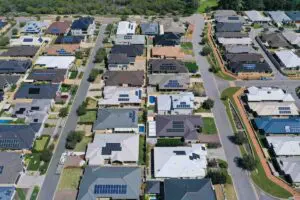As solar and wind energy continue to push down electricity sector emissions, new data shows that emissions from petrol and Australia’s fleet of inefficient and poorly regulated cars are on track to beat coal as the biggest source of greenhouse gases.
According to the March edition of the Australian Energy Emissions Monitor, petroleum use, when looked at from the perspective of emissions produced, is back to its nine-year normal trend, and rising, after a brief dip in 2020.

“On current trends, within less than two years, consumption of petroleum fuels will overtake combined emissions from electricity generation and other uses of natural gas as the largest source of fossil fuel greenhouse gas emissions in eastern Australia,” says the report, written by ANU’s Hugh Saddler.
“Also easy to see is a sharp increase in emissions from use of petroleum fuels during 2021 as air and passenger vehicle use reverted to their pre-pandemic levels. Since then, rather than levelling out, petroleum fuel consumption has shown slow but steady growth.”
LNG production also continues to deliver consistently high levels of emissions.

Petroleum might be in, but coal and gas are out
The rise and rise of renewable energy in the grid pushed out coal and gas generation.
Electricity emissions have steadily declined after the industry recovered from the Abbott government’s removal of the price on emissions and unsuccessful attempt to abolish the Renewable Energy Target.
In the electricity sector, the cost of using gas is stark: South Australia, which has the highest levels of wind and solar generation in the country and took 70 per cent of its energy demand from those sources last year, must still rely on gas turbines in winter which pushes wholesale prices sharply upwards.
“The states with higher shares of wind and solar generation have had consistently much lower wholesale prices,” the report said.
“In the year to February 2023, renewable generation supplied 30 per cent of grid scale electricity generated in the National Energy Market, 68 per cent in South Australia, 32 per cent in Victoria, 24 per cent in New South Wales, and only 14 per cent in Queensland.
“During the seven months starting August 2022, i.e. since extremely high wholesale electricity prices came to an end, volume weighted spot wholesale prices have been consistently up to $40 per MWh lower in Victoria and South Australia than corresponding prices in New South Wales and Queensland.”
Saddler says Victoria is likely to achieve its legislated renewable generation target but late-starter Queensland is likely to struggle.










